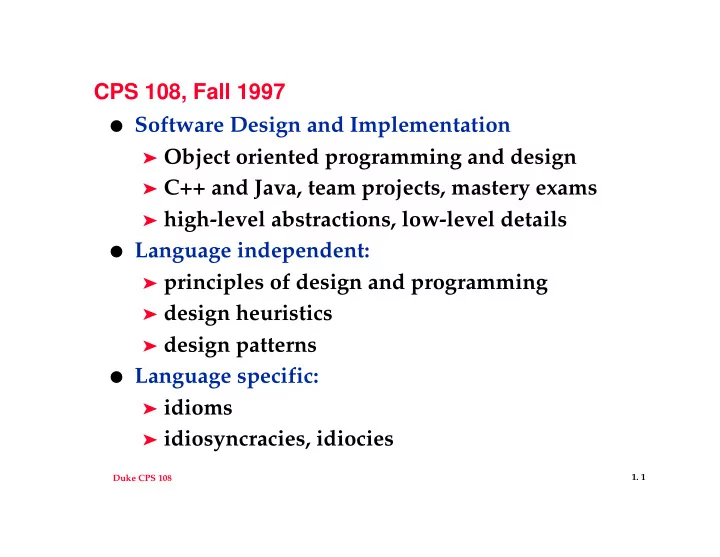

CPS 108, Fall 1997 ● Software Design and Implementation ➤ Object oriented programming and design ➤ C++ and Java, team projects, mastery exams ➤ high-level abstractions, low-level details ● Language independent: ➤ principles of design and programming ➤ design heuristics ➤ design patterns ● Language specific: ➤ idioms ➤ idiosyncracies, idiocies 1. 1 Duke CPS 108
Administrivia ● check website and news regularly http://www.cs.duke.edu/~ola/courses/cps108.html duke.cs.cps108 ● Grading (see web pages) ➤ group projects: small, medium, large ➤ mastery programs (solo endeavors) ➤ tests ● Evaluating team projects, role of TA, UTA, consultants ● Compiling, tools, environments, Linux 1. 2 Duke CPS 108
C++ idioms/general concepts ● templates ➤ generic functions/container classes ● inheritance ➤ design guidelines, benefits, drawbacks ● low-level structures ➤ C-style arrays and strings compared to standard: STL, Tapestry ● from C to C++ ➤ function pointers, function objects ● build on generalities, transition to Java 1. 3 Duke CPS 108
Design Criteria Good design comes from experience, experience comes from bad design Fred Brooks (or Henry Petroski) ● Design with goals: ➤ ease of use ➤ portability ➤ ease of re-use ➤ efficiency ➤ first to market ➤ ????? 1. 4 Duke CPS 108
How to code ● Coding/Implementation goals: ➤ Make it run ➤ Make it right ➤ Make it fast ➤ Make it small ● spiral design (or RAD or waterfall or ...) design implementation specification 1. 5 Duke CPS 108
Design Heuristics: class and program rules-of-thumb (see text by Arthur Riel) ● Coupling ➤ classes/modules are independent of each other ➤ goal: minimal, loose coupling ➤ do classes collaborate and/or communicate? ● Cohesion ➤ classes/modules capture one abstraction/model ➤ keep things as simple as possible, but no simpler ➤ goal: strong cohesion (avoid kitchen sink) 1. 6 Duke CPS 108
Design patterns “... describes a problem which occurs over and over again in our environment, and then describes the core of the solution to that problem, in such a way that you can use this solution a million times over, without ever doing it the same way twice” Christopher Alexander, quoted in GOF ● Example: iterator (257) ➤ sequentially access elements of aggregate without exposing representation/implementation ➤ see DirEntry (scandir), List class, Map class (from CPS 100) ➤ heavily used in STL, with pointer like syntax 1. 7 Duke CPS 108
Pattern Essentials ● Name ➤ good name provides a handle for the pattern, makes it easy to remember and use: vocabulary ● Problem ➤ when the pattern is applicable, context, criteria to be met, design goals ● Solution ➤ design, collaborations, responsibilities, and relationships of the classes/design elements ● Consequences ➤ trade-offs, problems, results from applying pattern: help in evaluating applicability 1. 8 Duke CPS 108
hyperWAG ● hypertext version of week-at-a-glance, see web page for complete details ➤ read file in wagalang m 9,12 sleep th 9,10 cps 110 w 9,10 breakfast f 9,10 running mtwhf 12,13 lunch wf 10,12 cps 108 t 10,12 breakfast ➤ produce HTML table ● classes? problems? issues? groups? ideas? ● C++ questions, design questions 1. 9 Duke CPS 108
larger group/company issues see McCarthy, Dynamics of Software Development ● establish a shared vision ➤ what is hyperWAG? what can we add? ➤ harmonious sense of purpose ● develop a creative environment ➤ the more ideas the better, ideas are infectious ➤ don’t flip the BOZO bit ● scout the future ➤ what’s coming, what’s the next project ➤ what new technologies will affect this project 1. 10 Duke CPS 108
Recommend
More recommend